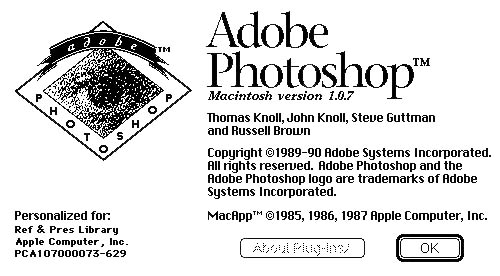This article is more than 1 year old
Adobe Photoshop celebrates big 2-0
What a long, layered trip it's been
Exactly 20 years ago today - Wednesday, February 24 - the first stable version of Adobe Photoshop was released into the wild. At 728 kilobytes, it fit on a single floppy disk.
To gain some insight into Photoshop's origins, we sat down with long-time Photoshop expert, author, and teacher David Biedny between his Photoshop sessions at the recent Macworld Expo in San Francisco.
Before Photoshop became Adobe Photoshop, when creators Tom and John Knoll were trying to find a home for it, Biedny was working with Mac developer SuperMac, then-publisher of PixelPaint, the first color paint app for the Apple Macintosh. "John Knoll had gone to [SuperMac] as one of the first companies that he wanted to pitch Photoshop to," Biedny told us, "and the director of product development there sent me a copy and said, 'What do you think of this?'
"The disk arrived in my office on a Friday afternoon in a FedEx envelope, and I put it on my Mac II...and by the time I came up for air it was Saturday morning."
That was the reaction many photo folks experienced - including your Reg reporter - when first encountering the app that not only changed photography forever, but which eventually gained the ultimate honor: it became a verb, a distinction reserved for such game-changers as Xerox and, yes, Google.

It was 20 years ago today...
Unfortunately for SuperMac - and fortunately for Adobe - the PixelPaint publishers turned Knoll down, reportedly because they didn't see how Photoshop could coexist with that color paint program.
But Photoshop wasn't the original image editor. "People will always remember Photoshop as the image editor, but the reality is that before Photoshop came on the scene, there had been a long history of graphics-editing software, really starting in many ways with a program called The Realist," Biedny told The Reg.
The developers of The Realist, Mark Zimmer and Tom Hedges, eventually sold the app to Letraset of FontStudio fame, which transformed it into ImageStudio, which morphed into ColorStudio - and there were things about ColorStudio, according to Biedny, that Photoshop was never able to replicate, such as a vector-based layer that sat on top of the bitmap that could be selectively rasterized and printed out with a fine-grained anti-aliasing.
While The Realist was going through its metamorphosis into ColorStudio, Photoshop's creators Thomas and John Knoll were developing the precursor to Photoshop - which was originally known as Display and then ImagePro after such tools as gamma correction were added.
The origin of the name Photoshop, according to Biedny, is obscure. "Tom said somebody - he hasn't mentioned who - gave him the name, but he hasn't really gone on the record to say who. And actually Adobe had done some work to try to figure out what to name it, but ended up going with the Photoshop name because at that point it already, kind of covertly, had recognition."
The Photoshop name took a left turn when scanner manufacturer Barneyscan licensed the app (version 0.87) in 1989 to bundle with their slide scanners, dubbing it Barneyscan XP. The deal was short-lived, with only around 200 copies shipped.
But that small seeding was important in one major way - one that explained how the Photoshop name had "covertly" gained recognition: the copy of Barneyscan XP/Photoshop that was included with the company's slide scanners wasn't copy-protected, and pirated copies soon began illegally wending their way around the graphics community.
The proverbial cat was out of the proverbial bag - but Photoshop had already been making its mark not in the graphics community, but among filmmakers.
